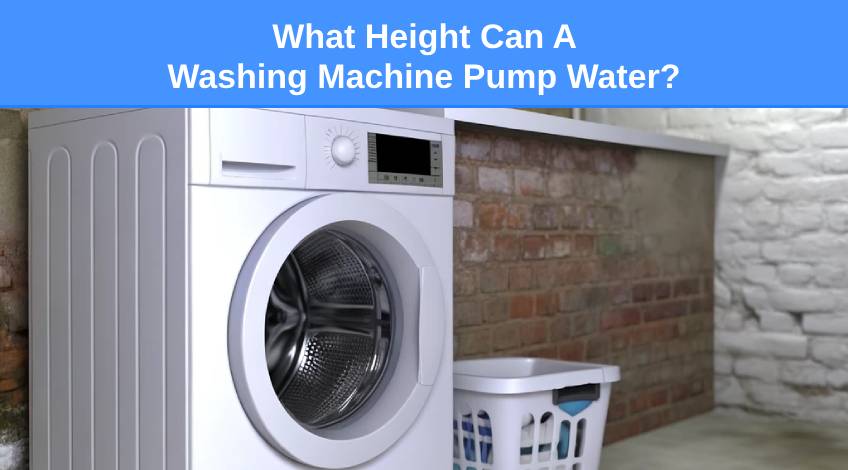
What Height Can A Washing Machine Pump Water?
You’re probably asking this question if you’re wanting to install a washing machine in a cellar or basement and all of the drains are up at ground level. You can install a washing machine in a basement and connect it to a drain up on ground level but only under certain conditions.
In this article I take a close look at how to successfully install a washer in a basement and get it to drain correctly. If you intend to set your washing machine up in the basement, keep reading.
How High Can A Washing Machine Pump Water?
If you intend to install your washing machine below ground level and away from any source of drainage, you’re going to need to know exactly how high it can pump the waste water after a wash and rinse cycle.
Depending on the type of washing machine you own as well as the type of motor it has and the condition of that motor, a washing machine can pump waste water from around 3 feet (0.9144 metres) to 6 to 8 feet (1.8 to 2.4 metres).
Which Type Of Washing Machine Can Pump Higher?

Generally top loaders can pump water higher than front loaders which means front loaders can typically only pump water around 3 feet (0.9144 metres) whereas top loaders tend to be able to achieve around 6 to 8 feet (1.8 to 2.4 metres).
This is because front loaders typically run using less water. However, that saving in water usage translates to a reduced pumping height. So whilst front loaders are more economical and use less water, they can’t pump water as high as top loaders.
Motor Power & Condition
You can typically expect a washer with a higher powered motor to be able to pump water higher than one with a lower powered motor. Then there’s the age and condition of the machine, both of these will factor into how high it can pump water.
You should expect a new machine to be able to pump water higher than an older machine for example.
What About Distance?

When it comes to how far the washing machine can pump waste water vertically, they average at around 150 feet (45 metres). However, the length a washing machine can pump vertically is often proportional to how far it can pump horizontally.
It all depends on certain conditions which include;
The Strength Of The Pump
The more power the pump has, the higher it can pump waste water and the further it can pump it as well.
The Length Of The Drain Hose
Washing machine drain hoses come in various lengths and the longer the drain hose supplied with your washer, the further the water is likely to pump. However, it is possible to extend drain hoses as long as they are running downhill.
This allows the downward slope to help move the water along the hose. You will also need to ensure the hose isn’t twisted, kinked or blocked as these could affect the flow of water and lead to flooding.
How High Should The Drain Hose Be Elevated?
Washing machine drain hoses should be elevated to somewhere between 16 to 40 inches (40 to 100 cm). The hose should then run into a standpipe and not extend into the standpipe for more than 6 inches (15 cm). If the drain hose is less than 16 inches (40 cm) high it could cause waste water to backflow into the appliance.
How To Get A Washing Machine To Pump Water From A Basement Up To Ground Level

You might think that all you need to do is extend the drain hose on the washing machine and run it up to the ground level. However, this can cause problems because the water would drain at such a slow rate that the appliance would abort the cycle.
You could try raising the washer on a high mounting which could help from a drainage point of view. But it isn’t any good from a practical perspective.
This is because the height needed to get the water to pump up to ground level would mean that you’d need a ladder to reach the detergent dispenser on the washer.
Plus you would need to find a sturdy support for the appliance to prevent it from falling during spin cycles where excessive vibration takes place.
Obviously, if the machine were to fall from its perch, it could have disastrous results. You can buy special bases specifically designed to raise the height of a washing machine safely.
However, these are designed to raise the washer by around 12 inches (30 cm) which wouldn’t be enough to make any difference to the pumping height required.
The Correct Way To Install A Washing Machine In A Basement
The first requirement is that the room has been treated for any damp issues that are often prevalent in cellars or basements. You would then need to install a pump booster system specifically designed to increase the distance in height that waste water can be pumped.
In the UK the main company producing this kind of pump booster system is Saniflo but these systems are fairly expensive and will need to be installed by a plumber.
There are other brands available online at lower prices but it is best to be guided by the plumber as they may have a preference.
SEE ALSO: Do You Need To Elevate A Washing Machine Drain Hose?
Frequently Asked Questions
A washing machine can pump water uphill but only to a height of between 3 feet (0.9144 metres) to 6 to 8 feet (1.8 to 2.4 metres). Any higher than this would almost certainly result in the water flowing back into the washer.
Whilst it is possible to install a washing machine in a basement, you may encounter problems with getting the wastewater up to a ground level drain. It is possible that because the washer detects slow drainage, that it will abort any wash cycle. You will need to install a pump booster system which can be quite expensive.
Depending on the strength of the pump, the age of the washer and the power rating of its motor, a washing machine can pump water up to 150 feet (45 metres) horizontally and between around 3 feet (0.9144 metres) to 6 to 8 feet (1.8 to 2.4 metres) vertically.
Also, follow us on Pinterest ...



